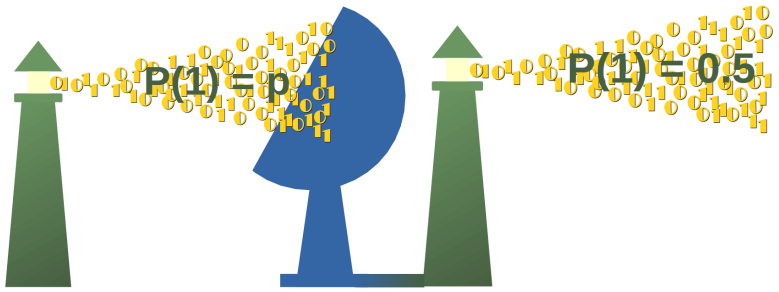 In the previous chapter of our tutorial, we introduced the random module. We got to know the functions 'choice' and 'sample'. We used
'choice' to choose a random element from a non-empty sequence and 'sample' to chooses k unique random elements from a population sequence or set. The probality for all elements is evenly distributed, i.e. each element has of the sequences or sets have the same probability to be chosen.
This is exactly what we want, if we simulate the rolling of dice. But what about loaded dice? Loaded dice are designed to favor some results over others for whatever reasons.
In our previous chapter we had a look at the following examples:
In the previous chapter of our tutorial, we introduced the random module. We got to know the functions 'choice' and 'sample'. We used
'choice' to choose a random element from a non-empty sequence and 'sample' to chooses k unique random elements from a population sequence or set. The probality for all elements is evenly distributed, i.e. each element has of the sequences or sets have the same probability to be chosen.
This is exactly what we want, if we simulate the rolling of dice. But what about loaded dice? Loaded dice are designed to favor some results over others for whatever reasons.
In our previous chapter we had a look at the following examples:
from random import choice, sample
print(choice("abcdefghij"))
professions = ["scientist", "philosopher", "engineer", "priest"]
print(choice(professions))
print(choice(("beginner", "intermediate", "advanced")))
# rolling one die
x = choice(range(1, 7))
print("The dice shows: " + str(x))
# rolling two dice:
dice = sample(range(1, 7), 2)
print("The two dice show: " + str(dice))
Like we said before, the chances for the elements of the sequence to be chosen are evenly distributed. So the chances for getting a 'scientist' as a return value of the call choice(professions) is 1/4. This is out of touch with reality. There are surely more scientists and engineers in the world than there are priests and philosophers. Just like with the loaded die, we have again the need of a weighted choice.
We will devise a function "weighted_choice", which returns a random element from a sequence like random.choice, but the elements of the sequence will be weighted.
We will define now the weighted choice function. Let's assume that we have three weights, e.g. 1/5, 1/2, 3/10. We can build the cumulative sum of the weights with np.cumsum(weights).
import numpy as np
weights = [0.2, 0.5, 0.3]
cum_weights = [0] + list(np.cumsum(weights))
print(cum_weights)
If we create a random number x between 0 and 1 by using random.random(), the probability for x to lie within the interval [0, cum_weights[0]) is equal to 1/5. The probability for x to lie within the interval [cum_weights[0], cum_weights[1]) is equal to 1/2 and finally, the probability for x to lie within the interval [cum_weights[1], cum_weights[2]) is 3/10.
Now you are able to understand the basic idea of how weighted_choice operates:
import numpy as np
import random
from random import random
def weighted_choice(objects, weights):
""" returns randomly an element from the sequence of 'objects',
the likelihood of the objects is weighted according
to the sequence of 'weights', i.e. percentages."""
weights = np.array(weights, dtype=np.float64)
sum_of_weights = weights.sum()
# standardization:
np.multiply(weights, 1 / sum_of_weights, weights)
weights = weights.cumsum()
x = random()
for i in range(len(weights)):
if x < weights[i]:
return objects[i]
Example:
We can use the function weighted_choice for the following task:
Suppose, we have a "loaded" die with P(6)=3/12 and P(1)=1/12. The probability for the outcomes of all the other possibilities is equally likely,
i.e. P(2) = P(3) = P(4) = P(5) = p.
We can calculate p with
1 - P(1) - P(6) = 4 x p
that means
p = 1 / 6
How can we simulate this die with our weighted_choice function?
We call weighted_choice with 'faces_of_die' and the 'weights' list. Each call correspondents to a throw of the loaded die.
We can show that if we throw the die a large number of times, for example 10,000 times, we get roughly the probability values of the weights:
from collections import Counter
faces_of_die = [1, 2, 3, 4, 5, 6]
weights = [1/12, 1/6, 1/6, 1/6, 1/6, 3/12]
outcomes = []
n = 10000
for _ in range(n):
outcomes.append(weighted_choice(faces_of_die, weights))
c = Counter(outcomes)
for key in c:
c[key] = c[key] / n
print(sorted(c.values()), sum(c.values()))
We can also use list of strings with our 'weighted_choice' function.
We define a list of cities and a list with their corresponding populations. The probability of a city to be chosen should be according to their size:
cities = ["Frankfurt",
"Stuttgart",
"Freiburg",
"München",
"Zürich",
"Hamburg"]
populations = [736000, 628000, 228000, 1450000, 409241, 1841179]
total = sum(populations)
weights = [ round(pop / total, 2) for pop in populations]
print(weights)
for i in range(10):
print(weighted_choice(cities, populations))
Weighted Random Choice with Numpy
To produce a weighted choice of an array like object, we can also use the choice function of the numpy.random package. Actually, you should use functions from well-established module like 'NumPy' instead of reinventing the wheel by writing your own code. In addition the 'choice' function from NumPy can do even more. It generates a random sample from a given 1-D array or array like object like a list, tuple and so on. The function can be called with four parameters:
choice(a, size=None, replace=True, p=None)| Parameter | Meaning |
|---|---|
| a | a 1-dimensional array-like object or an int. If it is an array-like object, the function will return a random sample from the elements. If it is an int, it behaves as if we called it with np.arange(a) |
| size | This is an optional parameter defining the output shape. If the given shape is, e.g., (m, n, k), then m * n * k samples are drawn. The Default is None, in which case a single value will be returned. |
| replace | An optional boolean parameter. It is used to define whether the output sample will be with or without replacements. |
| p | An optional 1-dimensional array-like object, which contains the probabilities associated with each entry in a. If it is not given the sample assumes a uniform distribution over all entries in a. |
We will base our first exercise on the popularity of programming language as stated by the "Tiobe index"1:
from numpy.random import choice
professions = ["scientist",
"philosopher",
"engineer",
"priest",
"programmer"]
probabilities = [0.2, 0.05, 0.3, 0.15, 0.3]
choice(professions, p=probabilities)
Let us use the function choice to create a sample from our professions. To get two professions chosen, we set the sizeparameter to the shape (2, ). In this case multiple occurances are possible. The top ten programming languages in August 2019 were:
| Programming Language | Percentage in August 2019 | Change to August 2018 | ||
|---|---|---|---|---|
| Java | 16.028% | -0.85% | ||
| C | 15.154% | +0.19% | ||
| Python | 10.020% | +3.03% | ||
| C++ | 6.057% | -1.41% | ||
| C# | 3.842% | +0.30% | ||
| Visual | Basic | .NET | 3.695% | -1.07% |
| JavaScript | 2.258% | -0.15% | ||
| PHP | 2.075% | -0.85% | ||
| Objective-C | 1.690% | +0.33% | ||
| SQL | 1.625% | -0.69% | ||
| Ruby | 1.316% | +0.13% |
programming_languages = ["Java", "C", "Python", "C++"]
weights = np.array([16, 15.2, 10, 6.1])
# normalization
weights /= sum(weights)
print(weights)
for i in range(10):
print(choice(programming_languages, p=weights))
Weighted Sample
In the previous chapter on random numbers and probability, we introduced the function 'sample' of the module 'random' to randomly extract a population or sample from a group of objects liks lists or tuples. Every object had the same likelikhood to be drawn, i.e. to be part of the sample.
In real life situation there will be of course situation in which every or some objects will have different probabilities. We will start again by defining a function on our own. This function will use the previously defined 'weighted_choice' function.
def weighted_sample(population, weights, k):
"""
This function draws a random sample (without repeats)
of length k from the sequence 'population' according
to the list of weights
"""
sample = set()
population = list(population)
weights = list(weights)
while len(sample) < k:
choice = weighted_choice(population, weights)
sample.add(choice)
index = population.index(choice)
weights.pop(index)
population.remove(choice)
weights = [ x / sum(weights) for x in weights]
return list(sample)
Example using the sample function:
Let's assume we have eight candies, coloured "red", "green", "blue", "yellow", "black", "white", "pink", and "orange". Our friend Peter will have the "weighted" preference 1/24, 1/6, 1/6, 1/12, 1/12, 1/24, 1/8, 7/24 for thes colours. He is allowed to take 3 candies:
candies = ["red", "green", "blue", "yellow", "black", "white", "pink", "orange"]
weights = [ 1/24, 1/6, 1/6, 1/12, 1/12, 1/24, 1/8, 7/24]
for i in range(10):
print(weighted_sample(candies, weights, 3))
Let's approximate the likelihood for an orange candy to be included in the sample:
n = 100000
orange_counter = 0
for i in range(n):
if "orange" in weighted_sample(candies, weights, 3):
orange_counter += 1
print(orange_counter / n)
It was completely unnecessary to write this function, because we can use the choice function of NumPy for this purpose as well. All we have to do is assign the shape '(2, )' to the optional parameter 'size'. Let us redo the previous example by substituting weighted_sampe with a call of np.random.choice:
n = 100000
orange_counter = 0
for i in range(n):
if "orange" in np.random.choice(candies,
p=weights,
size=(3,),
replace=False):
orange_counter += 1
print(orange_counter / n)
In addition, the function 'np.random.choice' gives us the possibility to allow repetitions, as we can see in the following example:
countries = ["Germany", "Switzerland",
"Austria", "Netherlands",
"Belgium", "Poland",
"France", "Ireland"]
weights = np.array([83019200, 8555541, 8869537,
17338900, 11480534, 38413000,
67022000, 4857000])
weights = weights / sum(weights)
for i in range(4):
print(np.random.choice(countries,
p=weights,
size=(3,),
replace=True))
Cartesian Choice
The function cartesian_choice is named after the Cartesian product from set theory
Cartesian product
The Cartesian product is an operation which returns a set from multiple sets. The result set from the Cartesian product is called a "product set" or simply the "product".
For two sets A and B, the Cartesian product A × B is the set of all ordered pairs (a, b) where a ∈ A and b ∈ B:
A x B = { (a, b) | a ∈ A and b ∈ B }
If we have n sets A1, A2, ... An, we can build the Cartesian product correspondingly:
A1 x A2 x ... x An = { (a1, a2, ... an) | a1 ∈ A1, a2 ∈ A2, ... an ∈ An]
The Cartesian product of n sets is sometimes called an n-fold Cartesian product.
Cartesian Choice: cartesian_choice
We will write now a function cartesian_choice, which takes an arbitrary number of iterables as arguments and returns a list, which consists of random choices from each iterator in the respective order.
Mathematically, we can see the result of the function cartesian_choice as an element of the Cartesian product of the iterables which have been passed as arguments.
import numpy as np
def cartesian_choice(*iterables):
"""
A list with random choices from each iterable of iterables
is being created in respective order.
The result list can be seen as an element of the
Cartesian product of the iterables
"""
res = []
for population in iterables:
res.append(np.random.choice(population))
return res
cartesian_choice(["The", "A"],
["red", "green", "blue", "yellow", "grey"],
["car", "house", "fish", "light"],
["smells", "dreams", "blinks", "shines"])
We define now a weighted version of the previously defined function:
import numpy as np
def weighted_cartesian_choice(*iterables):
"""
An arbitrary number of tuple or lists,
each consisting of population and weights.
weighted_cartesian_choice returns a list
with a chocie from each population
"""
res = []
for population, weights in iterables:
# normalize weight:
weights = np.array(weights) / sum(weights)
lst = np.random.choice(population, p=weights)
res.append(lst)
return res
determiners = (["The", "A", "Each", "Every", "No"],
[0.3, 0.3, 0.1, 0.1, 0.2])
colours = (["red", "green", "blue", "yellow", "grey"],
[0.1, 0.3, 0.3, 0.2, 0.2])
nouns = (["water", "elephant", "fish", "light", "programming language"],
[0.3, 0.2, 0.1, 0.1, 0.3])
nouns2 = (["of happiness", "of chocolate", "of wisdom", "of challenges", "of air"],
[0.5, 0.2, 0.1, 0.1, 0.1])
verb_phrases = (["smells", "dreams", "thinks", "is made of"],
[0.4, 0.3, 0.2, 0.1])
print("It may or may not be true:")
for i in range(10):
res = weighted_cartesian_choice(determiners,
colours,
nouns,
verb_phrases,
nouns2)
print(" ".join(res) + ".")
We check in the following version, if the "probabilities" are all right:
import random
def weighted_cartesian_choice(*iterables):
"""
A list with weighted random choices from each iterable of iterables
is being created in respective order
"""
res = []
for population, weight in iterables:
lst = weighted_choice(population, weight)
res.append(lst)
return res
determiners = (["The", "A", "Each", "Every", "No"],
[0.3, 0.3, 0.1, 0.1, 0.2])
colours = (["red", "green", "blue", "yellow", "grey"],
[0.1, 0.3, 0.3, 0.2, 0.2])
nouns = (["water", "elephant", "fish", "light", "programming language"],
[0.3, 0.2, 0.1, 0.1, 0.3])
nouns2 = (["of happiness", "of chocolate", "of wisdom", "of challenges", "of air"],
[0.5, 0.2, 0.1, 0.1, 0.1])
verb_phrases = (["smells", "dreams", "thinks", "is made of"],
[0.4, 0.3, 0.2, 0.1])
print("It may or may not be true:")
sentences = []
for i in range(10000):
res = weighted_cartesian_choice(determiners,
colours,
nouns,
verb_phrases,
nouns2)
sentences.append(" ".join(res) + ".")
words = ["smells", "dreams", "thinks", "is made of"]
from collections import Counter
c = Counter()
for sentence in sentences:
for word in words:
if word in sentence:
c[word] += 1
wsum = sum(c.values())
for key in c:
print(key, c[key] / wsum)

A random seed, - also called "seed state", or just "seed" - is a number used to initialize a pseudorandom number generator. When we called random.random() we expected and got a random number between 0 and 1. random.random() calculates a new random number by using the previously produced random number. What about the first time we use random in our program? Yes, there is no previously created random number. If a random number generator is called for the first time, it will have to create a first "random" number.
If we seed a pseudo-random number generator, we provide a first "previous" value. A seed value corresponds to a sequence of generated values for a given random number generator. If you use the same seed value again, you get and you can rely on getting the same sequence of numbers again.
The seed number itself doesn't need to be randomly chosen so that the algorithm creates values which follow a probability distribution in a pseudorandom manner. Yet, the seed matters in terms of security. If you know the seed, you could for example generate the secret encryption key which is based on this seed.
Random seeds are in many programming languages generated from the state of the computer system, which is in lots of cases the system time.
This is true for Python as well. Help on random.seed says that if you call the function with None or no argument it will seed "from current time or from an operating system specific randomness source if available."
import random
help(random.seed)
The seed functions allows you to get a determined sequence of random numbers. You can repeat this sequence, whenever you need it again, e.g. for debugging purposes.
import random
random.seed(42)
for _ in range(10):
print(random.randint(1, 10), end=", ")
print("\nLet's create the same random numbers again:")
random.seed(42)
for _ in range(10):
print(random.randint(1, 10), end=", ")
from random import gauss
n = 1000
values = []
frequencies = {}
while len(values) < n:
value = gauss(180, 30)
if 130 < value < 230:
frequencies[int(value)] = frequencies.get(int(value), 0) + 1
values.append(value)
print(values[:10])
The following program plots the random values, which we have created before. We haven't covered matplotlib so far, so it's not necessary to understand the code:
%matplotlib inline
import matplotlib.pyplot as plt
freq = list(frequencies.items())
freq.sort()
plt.plot(*list(zip(*freq)))
We do the same now with normvariate instead of gauss:
from random import normalvariate
n = 1000
values = []
frequencies = {}
while len(values) < n:
value = normalvariate(180, 30)
if 130 < value < 230:
frequencies[int(value)] = frequencies.get(int(value), 0) + 1
values.append(value)
freq = list(frequencies.items())
freq.sort()
plt.plot(*list(zip(*freq)))
It might be a good idea to write the following function as an exercise yourself. The function should be called with a parameter p, which is a probabilty value between 0 and 1. The function returns a 1 with a probability of p, i.e. ones in p percent and zeros in (1 - p) percent of the calls:
import random
def random_ones_and_zeros(p):
""" p: probability 0 <= p <= 1
returns a 1 with the probability p
"""
x = random.random()
if x < p:
return 1
else:
return 0
Let's test our little function:
n = 1000000
sum(random_ones_and_zeros(0.8) for i in range(n)) / n
It might be a great idea to implement a task like this with a generator. If you are not familar with the way of working of a Python generator, we recommend to consult our chapter on generators and iterators of our Python tutorial.
import random
def random_ones_and_zeros(p):
while True:
x = random.random()
yield 1 if x < p else 0
def firstn(generator, n):
for i in range(n):
yield next(generator)
n = 1000000
sum(x for x in firstn(random_ones_and_zeros(0.8), n)) / n
Our generator random_ones_and_zeros can be seen as a sender, which emits ones and zeros with a probability of p and (1-p) respectively.
We will write now another generator, which is receiving this bitstream. The task of this new generator is to read the incoming bitstream and yield another bitstream with ones and zeros with a probability of 0.5 without knowing or using the probability p. It should work for an arbitrary probability value p.2

def ebitter(bitstream):
while True:
bit1 = next(bitstream)
bit2 = next(bitstream)
if bit1 + bit2 == 1:
bit3 = next(bitstream)
if bit2 + bit3 == 1:
yield 1
else:
yield 0
def ebitter2(bitstream):
bit1 = next(bitstream)
bit2 = next(bitstream)
bit3 = next(bitstream)
while True:
if bit1 + bit2 == 1:
if bit2 + bit3 == 1:
yield 1
else:
yield 0
bit1, bit2, bit3 = bit2, bit3, next(bitstream)
n = 1000000
sum(x for x in firstn(ebitter(random_ones_and_zeros(0.8)), n)) / n
n = 1000000
sum(x for x in firstn(ebitter2(random_ones_and_zeros(0.8)), n)) / n
Underlying theory:
Our first generator emits a bitstream B0, B1, B2,...
We check now an arbitrary pair of consecutive Bits Bi, Bi+1, ...
Such a pair can have the values 01, 10, 00 or 11. The probability P(01) = (p-1) x p and probability P(10) = p x (p-1), so that the combined probabilty that the two consecutive bits are either 01 or 10 (or the sum of the two bits is 1) is 2 x (p-1) x p
Now we look at another bit Bi+2. What is the probability that both
Bi + Bi+1 = 1
and
Bi+1 + Bi+2 = 1?
The possible outcomes satisfying these conditions and their corresponding probabilities can be found in the following table:
| Probability | Bi | Bi+1 | Bi+2 |
|---|---|---|---|
| p2 x (1-p) | 0 | 1 | 0 |
| p x (1 - p)2 | 1 | 0 | 1 |
We will denote the outcome sum(Bi, Bi+1)=1 asX1 and correspondingly the outcome sum(Bi+1, Bi+2)=1 as X2
So, the joint probability P(X1, X2) = p2 x (1-p) + p x (1 - p)2 which can be rearranged to p x (1-p)
The conditional probability of X2 given X1:
P(X2 | X1) = P(X1, X2) / P(X2)
P(X2 | X1) = p x (1-p) / 2 x p x (1-p) = 1 / 2
Synthetical Sales Figures
In this subchapter we want to create a data file with sales figures. Imagine that we have a chain of shops in various European and Canadian cities: Frankfurt, Munich, Berlin, Zurich, Hamburg, London, Toronto, Strasbourg, Luxembourg, Amsterdam, Rotterdam, The Hague
We start with an array 'sales' of sales figures for the year 1997:
import numpy as np
sales = np.array([1245.89, 2220.00, 1635.77, 1936.25, 1002.03, 2099.13, 723.99, 990.37, 541.44, 1765.00, 1802.84, 1999.00])
The aim is to create a comma separated list like the ones you get from Excel. The file should contain the sales figures, we don't know, for all the shops, we don't have, spanning the year from 1997 to 2016.
We will add random values to our sales figures year after year. For this purpose we construct an array with growthrates. The growthrates can vary between a minimal percent value (min_percent) and maximum percent value (max_percent):
min_percent = 0.98 # corresponds to -1.5 %
max_percent = 1.06 # 6 %
growthrates = (max_percent - min_percent) * np.random.random_sample(12) + min_percent
print(growthrates)
To get the new sales figures after a year, we multiply the sales array "sales" with the array "growthrates":
sales * growthrates
To get a more sustainable sales development, we change the growthrates only every four years.
This is our complete program, which saves the data in a file called sales_figures.csv:
import numpy as np
fh = open("sales_figures.csv", "w")
fh.write("Year, Frankfurt, Munich, Berlin, Zurich, Hamburg, London, Toronto, Strasbourg, Luxembourg, Amsterdam, Rotterdam, The Hague\n")
sales = np.array([1245.89, 2220.00, 1635.77, 1936.25, 1002.03, 2099.13, 723.99, 990.37, 541.44, 1765.00, 1802.84, 1999.00])
for year in range(1997, 2016):
line = str(year) + ", " + ", ".join(map(str, sales))
fh.write(line + "\n")
if year % 4 == 0:
min_percent = 0.98 # corresponds to -1.5 %
max_percent = 1.06 # 6 %
growthrates = (max_percent - min_percent) * np.random.random_sample(12) + min_percent
#growthrates = 1 + (np.random.rand(12) * max_percent - negative_max) / 100
sales = np.around(sales * growthrates, 2)
fh.close()
The result is in the file sales_figures.csv.
We will use this file in our chapter on reading and writing in Numpy.
Exercises
- Let's do some more die rolling. Prove empirically - by writing a simulation program - that the probability for the combined events "an even number is rolled" (E) and "A number greater than 2 is rolled" is 1/3.
- The file ["universities_uk.txt"](universities_uk.txt) contains a list of universities in the United Kingdom by enrollment from 2013-2014 (data from ([Wikepedia](https://en.wikipedia.org/wiki/List_of_universities_in_the_United_Kingdom_by_enrollment#cite_note-1)). Write a function which returns a tuple (universities, enrollments, total_number_of_students) with - universities: list of University names - enrollments: corresponding list with enrollments - total_number_of_students: over all universities Now you can enroll a 100,000 fictional students with a likelihood corresponding to the real enrollments.

Let me take you back in time and space in our next exercise. We will travel back into ancient Pythonia (Πηθωνια). It was the time when king Pysseus ruled as the benevolent dictator for live. It was the time when Pysseus sent out his messengers throughout the world to announce that the time has come for his princes Anacondos (Ανακονδος), Cobrion (Κομπριον), Boatos (Μποατος) and Addokles (Ανδοκλης) to merry. So, they organized the toughest programming contests amongst the fair and brave amazons, better known as Pythonistas of Pythonia. Finally, only eleven amazons were left to choose from:
1) The ethereal Airla (Αιρλα) 2) Barbara (Βαρβάρα), the one from a foreign country. 3) Eos (Ηως), looking divine in dawn 4) The sweet Glykeria (Γλυκερία) 5) The gracefull Hanna (Αννα) 6) Helen (Ελενη), the light in the dark 7) The good angel Agathangelos (Αγαθάγγελος) 8) the violet tinted cloud Iokaste (Ιοκάστη) 9) Medousa (Μέδουσα), the guardian 10) the self-controlled Sofronia (Σωφρονία) 11) Andromeda (Ανδρομεδα), the one who thinks man or a warrior.
On the day they arrived the chances to be drawn in the lottery are the same for every amazon, but Pysseus wants the lottery to be postponed to some day in the future. The probability changes every day: It will be lowered by 1/13 for the first seven amazones and it will be increased by 1/12 for the last four amazones.
How long will the king have to wait until he can be more than 90 percent sure that his princes Anacondos, Cobrion, Boatos and Addokles will be married to Iokaste, Medousa, Sofronia and Andromeda?
</li>
</ol>
Solutions to our exercises
from random import randint
outcomes = [ randint(1, 6) for _ in range(10000)]
even_pips = [ x for x in outcomes if x % 2 == 0]
greater_two = [ x for x in outcomes if x > 2]
combined = [ x for x in outcomes if x % 2 == 0 and x > 2]
print(len(even_pips) / len(outcomes))
print(len(greater_two) / len(outcomes))
print(len(combined) / len(outcomes))
At first we will write the function "process_datafile" to process our data file:
def process_datafile(filename):
""" process_datafile -> (universities,
enrollments,
total_number_of_students)
universities: list of University names
enrollments: corresponding list with enrollments
total_number_of_students: over all universities
"""
universities = []
enrollments = []
with open(filename) as fh:
total_number_of_students = 0
fh.readline() # get rid of descriptive first line
for line in fh:
line = line.strip()
*praefix, undergraduates, postgraduates, total = line.rsplit()
university = praefix[1:]
total = int(total.replace(",", ""))
enrollments.append(total)
universities.append(" ".join(university))
total_number_of_students += total
return (universities, enrollments, total_number_of_students)
Let's start our function and check the results:
universities, enrollments, total_students = process_datafile("universities_uk.txt")
for i in range(14):
print(universities[i], end=": ")
print(enrollments[i])
print("Total number of students onrolled in the UK: ", total_students)
We want to enroll now a virtual student randomly to one of the universities. To get a weighted list suitable for our weighted_choice function, we have to normalize the values in the list enrollments:
normalized_enrollments = [ students / total_students for students in enrollments]
# enrolling a virtual student:
print(weighted_choice(universities, normalized_enrollments))
We have been asked by the exercise to "enroll" 100,000 fictional students. This can be easily accomplished with a loop:
from collections import Counter
outcomes = []
n = 100000
for i in range(n):
outcomes.append(weighted_choice(universities, normalized_enrollments))
c = Counter(outcomes)
print(c.most_common(20))
</li>
The bunch of amazons is implemented as a list, while we choose a set for Pysseusses favorites. The weights at the beginning are 1/11 for all, i.e. 1/len(amazons).
Every loop cycle corresponds to a new day. Every time we start a new loop cycle, we will draw "n" samples of Pythonistas to calculate the ratio of the number of times the sample is equal to the king's favorites divided by the number of times the sample doesn't match the king's idea of daughter-in-laws. This corresponds to the probability "prob". We stop the first time, the probability is equal or larger than 0.9.
We can use both the function "weighted_same" and "weighted_sample_alternative" to do the drawing.
import time
amazons = ["Airla", "Barbara", "Eos",
"Glykeria", "Hanna", "Helen",
"Agathangelos", "Iokaste",
"Medousa", "Sofronia",
"Andromeda"]
weights = [ 1/len(amazons) for _ in range(len(amazons)) ]
Pytheusses_favorites = {"Iokaste", "Medousa",
"Sofronia", "Andromeda"}
n = 1000
counter = 0
prob = 1 / 330
days = 0
factor1 = 1 / 13
factor2 = 1 / 12
start = time.clock()
while prob < 0.9:
for i in range(n):
the_chosen_ones = weighted_sample_alternative(amazons, weights, 4)
if set(the_chosen_ones) == Pytheusses_favorites:
counter += 1
prob = counter / n
counter = 0
weights[:7] = [ p - p*factor1 for p in weights[:7] ]
weights[7:] = [ p + p*factor2 for p in weights[7:] ]
weights = [ x / sum(weights) for x in weights]
days += 1
print(time.clock() - start)
print("Number of days, he has to wait: ", days)
Teh value for the number of days differs, if n is not large enough.
The following is a solutions without round-off errors. We will use Fraction from the module fractions.
import time
from fractions import Fraction
amazons = ["Airla", "Barbara", "Eos",
"Glykeria", "Hanna", "Helen",
"Agathangelos", "Iokaste",
"Medousa", "Sofronia",
"Andromeda"]
weights = [ Fraction(1, 11) for _ in range(len(amazons)) ]
Pytheusses_favorites = {"Iokaste", "Medousa",
"Sofronia", "Andromeda"}
n = 1000
counter = 0
prob = Fraction(1, 330)
days = 0
factor1 = Fraction(1, 13)
factor2 = Fraction(1, 12)
start = time.clock()
while prob < 0.9:
#print(prob)
for i in range(n):
the_chosen_ones = weighted_sample_alternative(amazons, weights, 4)
if set(the_chosen_ones) == Pytheusses_favorites:
counter += 1
prob = Fraction(counter, n)
counter = 0
weights[:7] = [ p - p*factor1 for p in weights[:7] ]
weights[7:] = [ p + p*factor2 for p in weights[7:] ]
weights = [ x / sum(weights) for x in weights]
days += 1
print(time.clock() - start)
print("Number of days, he has to wait: ", days)
We can see that the solution with fractions is beautiful but very slow. Whereas the greater precision doesn't play a role in our case.
So far, we haven't used the power of Numpy. We will do this in the next implementation of our problem:
import time
import numpy as np
amazons = ["Airla", "Barbara", "Eos",
"Glykeria", "Hanna", "Helen",
"Agathangelos", "Iokaste",
"Medousa", "Sofronia",
"Andromeda"]
weights = np.full(11, 1/len(amazons))
Pytheusses_favorites = {"Iokaste", "Medousa",
"Sofronia", "Andromeda"}
n = 1000
counter = 0
prob = 1 / 330
days = 0
factor1 = 1 / 13
factor2 = 1 / 12
start = time.clock()
while prob < 0.9:
for i in range(n):
the_chosen_ones = weighted_sample_alternative(amazons, weights, 4)
if set(the_chosen_ones) == Pytheusses_favorites:
counter += 1
prob = counter / n
counter = 0
weights[:7] = weights[:7] - weights[:7] * factor1
weights[7:] = weights[7:] + weights[7:] * factor2
weights = weights / np.sum(weights)
#print(weights)
days += 1
print(time.clock() - start)
print("Number of days, he has to wait: ", days)
Footnotes:
1 The TIOBE index or The TIOBE Programming Community index is - according to the website "an indicator of the popularity of programming languages. The index is updated once a month. The ratings are based on the number of skilled engineers world-wide, courses and third party vendors. Popular search engines such as Google, Bing, Yahoo!, Wikipedia, Amazon, YouTube and Baidu are used to calculate the ratings. It is important to note that the TIOBE index is not about the best programming language or the language in which most lines of code have been written."
2 I am thankful to Dr. Hanno Baehr who introduced me to the problem of "Random extraction" when participating in a Python training course in Nuremberg in January 2014. Hanno outlined some bits of the theoretical framework. During a night session in a pub called "Zeit & Raum" (english: "Time & Space") I implemented a corresponding Python program to back the theoretical solution empirically.



